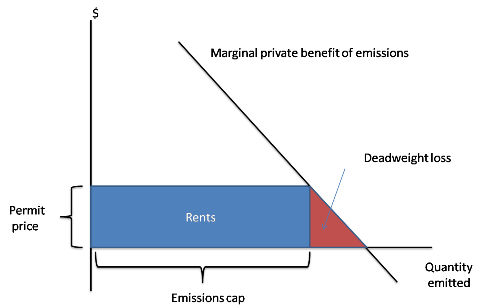Think of the benefits to the private sector from pollution. Yes, benefits — in the sense that it’s cheaper to pollute than not to, or that it’s easier to produce goods if you don’t worry about whatever emissions result as a byproduct. So we can think of drawing a curve representing the private marginal benefit of emissions, as in this figure:
In the absence of government action, the private sector will increase emissions up to the point where there is no further marginal benefit. That is, emissions will rise to whatever level is implied by profit-maximization, paying no attention to the effects on the environment.
A cap-and-trade system puts a limit on overall emissions, so that emitters have to pay a price for emitting. This price will, as shown in the figure above, equal the marginal benefit of the last unit of emissions allowed.
Now, the cost to the economy of this limit is the benefit the private sector would have gotten by emitting more than is allowed under the cap. It’s shown in the figure as the red triangle labeled “deadweight loss”. CBO puts these losses under Waxman-Markey at 0.2-0.7 percent of GDP in 2020, 1.1 to 3.4 percent in 2050. These costs have to be set against the environmental benefits.
In addition to this overall economic cost, there’s a distributional effect. The creation of cap and trade means that emission permits command a market price, and the value of these permits — the blue rectangle — goes to someone.
“Passion and prejudice govern the world; only under the name of reason” --John Wesley
Sunday, April 24, 2011
The textbook economics of cap-and-trade
Subscribe to:
Post Comments (Atom)

A cap-and-trade arrangement puts a absolute on all-embracing emissions, so that emitters accept to pay a amount for emitting.
ReplyDeleteHats
According to my knowledge i think that In other words, emissions means to reach any level is implicit in the maximization of profit, without regard to effects on the environment.
ReplyDeletehotels in hollywood fl
An array of caps and emissions trading is an absolute all-encompassing, so that issuers are willing to pay an amount for the show.
ReplyDelete